
Construction of the Manchester, Ashton-under-Lyne and Oldham Canal, to give it its full name, was authorised by five Acts of Parliament.
32 George III cap 84, Royal Assent 11 Jun 1792 33 George III cap 21, Royal Assent 28 Mar 1793 38 George III cap 32, Royal Assent 26 May 1798 39 & 40 George III cap 24, Royal Assent 16 May 1800 45 George III cap 11, Royal Assent 18 Mar 1805
The Preamble to the first Act:
AN A C T FOR Making a Navigable Canal from Manchester, to or near Ashton-under-Lyne, and Oldham, in the County Palatine of Lancaster.
Whereas the making and maintaining a canal for the Navigation of Boats, Barges, and other Vessels, from the Town of Manchester, at or near the Easterly End of a certain Highway or Street there, called Piccadilly, to or near a Place called Fairfield, in the Parish of Manchester, and from thence by One Branch to a certain Highway in the Town of Ashton-under-Lyne, near and leading to a Bridge called Dukinfield Bridge, and from or nearly from Fairfield aforesaid, by another Branch, to or near to the Town of Oldham, all in the County Palatine of Lancaster, will afford a short and expeditious Communication between the said respective Towns, and open a cheap and easy Introduction to many valuable Mines of Coal, and other Minerals, in the adjacent Counties, and be the Means of carrying and conveying Coals and other Minerals, Goods, Wares, Merchandizes, and other Articles, to and from the said respective Towns, and the Neighbourhood thereof, at a small Expense, and be in many other Respects of great Advantage to the Public.
The Second Bill authorised the construction of a branch from Clayton to the Three Boars Heads Inn at Heaton Norris, with another branch off this, along the side of the Tame Valley to Beat Bank in Denton. It also permitted the extension of the Hollinwood Branch from Waterhouses to Stake Leach at Hollinwood. Afterwards, the Werneth Colliery Company made a private extension to this, known as the Werneth Canal. This Bill was presented to Parliament on the 1 Feb 1793. By the 11 Feb, Thomas Brown had given evidence that the proposed extension (Hollinwood Branch) would provide a means of carrying coal. The names of Samuel Oldknow and Robert Peel (father of Prime Minister, Robert Peel) appear in this Bill. At this juncture, Thomas Brown was the Surveyor assisting Benjamin Outram but, curiously, Outram was not formally appointed as the Consulting Engineer until 1798.
The Third Bill was concerned with raising further funds and with paying compensation to land and property owners along the line of the Beat Bank Branch for loss and damage caused by the canal company. The decision to abandon the Beat Bank Branch before completion was brought about once the canal company was assured of long-term coal carrying on the extended Hollinwood Branch. Only a very short section of the Beat Bank Branch was actually put in water at Reddish.
The Fourth and Fifth Bills were mainly concerned with the raising of still more funds.
The opening dates of the Ashton Canal and its branches were not recorded. The Doncaster Journal and Yorkshire Advertiser makes reference to the Ashton Canal and Stockport Branch on the 4 Feb 1797. 'A canal conveyance was opened a few days ago between Stockport and Manchester, there has been one to Ashton for some months.' This suggests that the Stockport Branch opened in Jan 1797 and that the Ashton Canal opened in, say, Oct 1796 depending upon what is meant by the phrase, 'open for some months'.
The Ashton Canal is a narrow canal and it commences at a junction with the broad Rochdale Canal (not open when the Ashton Canal opened) at Ducie St, Piccadilly, Manchester and it proceeds via Ancoats, Beswick, Bradford, Clayton, Openshaw, Droylsden and Audenshaw to Ashton-under-Lyne where it makes a head-on junction with the Huddersfield Narrow Canal at Whitelands.
At Ancoats on the Ashton Canal there were a number of branches and arms of which the Islington Branch was the most important. The Stockport Branch commenced at Clayton (or Stockport) Junction on the Ashton Canal and passed through Openshaw, Gorton, Reddish and Heaton Norris to Stockport. The Hollinwood Branch commenced at Fairfield on the Ashton Canal and passed through Droylsden and Waterhouses (Daisy Nook) to Hollinwood. The Fairbottom Branch commenced at Waterhouses on the Hollinwood Branch to Bardsley (Fenny Field Bridge). At Ashton (Portland Basin) there is a short arm over the river Tame on an aqueduct, which makes a head-on connection with the Peak Forest Canal.
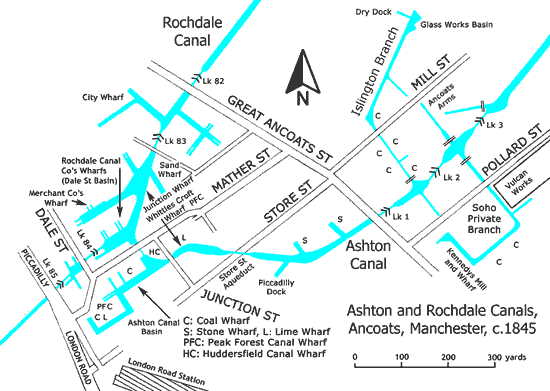
The two most important private branches on the Ashton Canal were the Bradford Private Branch between locks 6 and 7 and the Clayton Private Branch between locks 7 and 8.
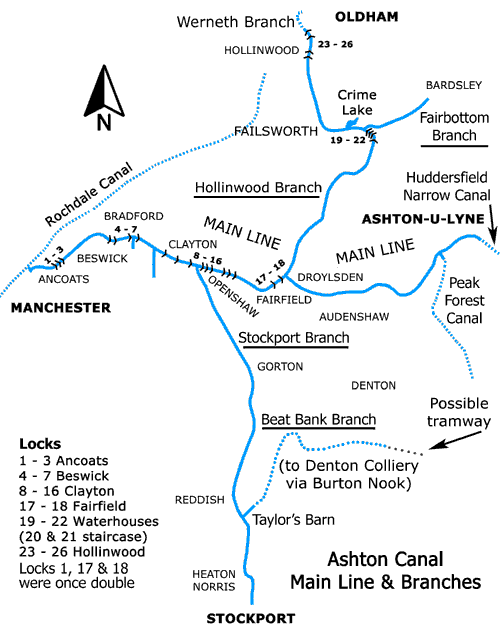
| Name | Length Miles Furlongs |
|---|---|
| Ashton Canal | 6 5½ |
| Islington Branch | 0 2 |
| Stockport Branch | 4 7 |
| Beat Bank Branch* | 2 4½ |
| Hollinwood Branch | 4 5 |
| Fairbottom Branch | 1 1 |
Ashton Canal Water Supply
The mainline of the Ashton Canal receives its water supply from three sources:
The Peak Forest Canal
By a gravity feeder from the river Tame near Mabholes
The Huddersfield Narrow Canal
Mabholes was a hamlet about 850 yards to the east of the terminus of the Ashton Canal at Whitelands on the north side of Whitelands Rd, Ashton-under-Lyne. There was once a farm by that name as well.
| 13 Sep 1791 | The Manchester Mercury reported that a petition was presented to Parliament for a canal to be constructed from Manchester to Ashton-under-Lyne and Oldham. Although there are no records, it is almost certain that Thomas Brown surveyed the line of the proposed canal, prepared the Deposited Plan and estimates for its construction. He was the Surveyor and Resident Engineer for the Peak Forest Canal Co. |
| 7 Feb 1792 | The Manchester Mercury reported that a General Meeting of subscribers was held. |
| 11 Jun 1792 | The first Act received the Royal assent. |
| 10 Jul 1792 | The first General Meeting of the Ashton Canal Co was held to put the first Act into execution. |
| 31 Jul 1792 | The Company advertised for an engineer to superintend the cutting of the canal. Around this time, James Meadows Sr was appointed as the company’s Principal Agent and engineer. |
| Late 1792 | Cutting the canal started at various sites. |
| 28 Mar 1793 | The second Act received the Royal Assent. This authorised the making of a branch canal from Clayton to Heaton Norris, Stockport, and a branch canal off this to Beat Bank, Denton. |
| 1794/95 | There was considerable financial activity with calls on subscribers to finance the works. |
| 4 Feb 1797 | The Doncaster Journal and Yorkshire Advertiser reported that a few days ago a canal conveyance was opened between Stockport and Manchester and that there had been one to Ashton for some months. This confirmed that the Ashton Canal and the Stockport Branch Canal were both open for trade. It appears that the canal was never declared to be fully open on any specific date. For example, the Stockport Branch Canal was not entirely completed until 1798 and the Beat Bank Branch Canal was never completed. |
| 26 May 1798 | The third Act received the Royal Assent. This Act authorised the raising of further funds. Additionally, it sanctioned compensation for land and property owners on the line of the abandoned Beat Bank Branch Canal for loss and damage caused by the company. |
| Circa Jun 1798 | Benjamin Outram, engineer for the Peak Forest Canal Co, is appointed as the engineer for the Ashton Canal Co. |
| 16 May 1800 | The fourth Act received the Royal Assent. This Act authorised the raising of further funds. |
| 18 Mar 1805 | The fifth Act received the Royal Assent. This Act authorised the raising of further funds. |
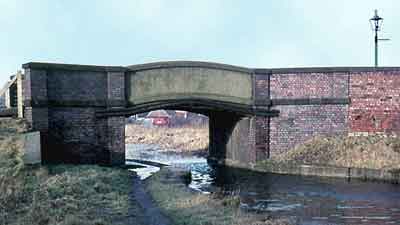 |
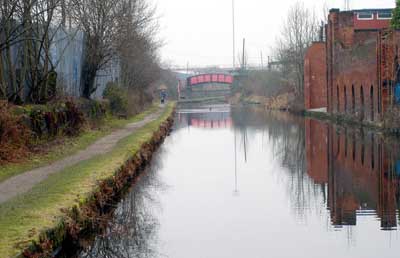 |
| Kershaw Lane Bridge, Audenshaw, looking west, 1960s. | Jeremy Brook Footbridge at the bottom of Pottinger St, Ashton-under-Lyne, looking west, Feb 2006. The buildings on the right are part of Oxford Mills. |
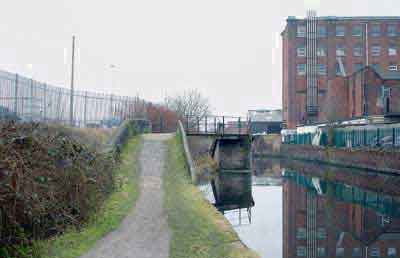 |
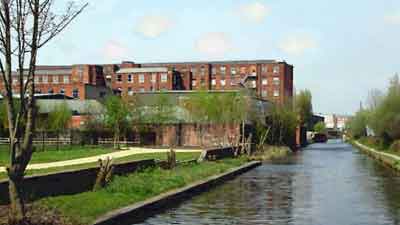 |
Prince's Dock, Ashton-under-Lyne, looking towards Guide Bridge, Feb 2006. This was used for the transhipment of goods to and from the adjacent railway. The buildings on the right are part of Oxford Mills. |
Oxford Mills looking north east along the Ashton Canal from Jeremy Brook Footbridge, 2009. These integrated mills on Oxford St East, Ashton-under-Lyne, consist of two cotton spinning mills on either side of a warehouse and office block. The first mill is dated 1840 and the second 1851. The warehouse and office block were built in c.1850. Weaving sheds attached to one of the mills are understood to have been built later. The mills were located beside the Ashton Canal to facilitate the delivery of raw cotton and coal to fire the boilers.They were erected by Thomas Mason who died in Audenshaw in 1868, aged 86 years. He was married to Mary Holden and their son, Hugh Mason (30 Jan 1817–2 Feb 1886) was a local philanthropist and MP. Oxford Mills were listed Grade II, List Entry No. 1084307. The mills caught fire at about 3:10pm on the 6 Aug 2019 during which three buildings were destroyed. The fire was still burning the next day. |